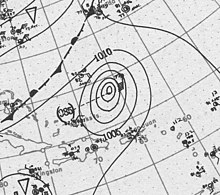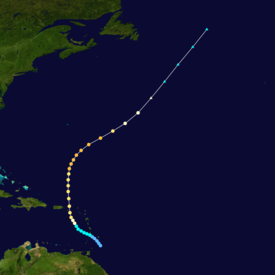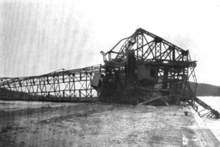1916 Virgin Islands hurricane
 Surface weather analysis of the hurricane moving north in the Sargasso Sea on October 11 | |
| Meteorological history | |
|---|---|
| Formed | October 6, 1916 |
| Dissipated | October 15, 1916 |
| Category 3 major hurricane | |
| 1-minute sustained (SSHWS/NWS) | |
| Highest winds | 120 mph (195 km/h) |
| Lowest pressure | 963 mbar (hPa); 28.44 inHg (Lowest directly measured[note 1]) |
| Overall effects | |
| Fatalities | 41 total |
| Damage | <$2 million (1916 USD) |
| Areas affected | |
| [3] | |
Part of the 1916 Atlantic hurricane season | |
The 1916 Virgin Islands hurricane was a strong
On the evening of October 9, the hurricane traversed the Virgin Islands with an intensity equivalent to a Category 2 on the modern Saffir–Simpson scale, passing directly over Saint Croix and producing gusts as high as 160 mph (260 km/h). Of the Danish West Indies, Saint Thomas fared worst, with virtually every building sustaining damage. The island harbor suffered greatly and numerous ships were grounded or sunk. Entire towns in Saint Croix and Tortola were destroyed. There were four deaths in Saint Thomas, five in the remainder of the Danish West Indies, and thirty-two in Tortola. After battering the Lesser Antilles, the hurricane continued harmlessly out to sea on a northward and later northeastward trajectory. While well southeast of Bermuda, the storm's intensity peaked on October 12 with maximum sustained winds of 120 mph (190 km/h). Steady weakening ensued thereafter, and the storm transitioned into an extratropical cyclone on October 14 before being absorbed by another cyclone east of Newfoundland a day later. Amid the storm's aftermath, coal carriers successfully went on strike for increased wages. Crop production in 1917 was significantly curtailed by the widespread damage wrought to agriculture by the hurricane.
Meteorological history

Tropical storm (39–73 mph, 63–118 km/h)
Category 1 (74–95 mph, 119–153 km/h)
Category 2 (96–110 mph, 154–177 km/h)
Category 3 (111–129 mph, 178–208 km/h)
Category 4 (130–156 mph, 209–251 km/h)
Category 5 (≥157 mph, ≥252 km/h)
Unknown
The 1916 Virgin Islands hurricane was the thirteenth known tropical cyclone of the
Curving towards the north,
Impact

Windward Islands and Puerto Rico
Inclement weather prevailed over the Windward Islands between October 7–8, yielding the storm's only discernible effects during its unclear origins. The developing system generated rough seas off Dominica; damaging waves in Roseau advanced well-inland.[6] Jetties and shore roads were washed away by the surf. Parts of coastal villages and small craft were lost to the heavy seas.[11] Buildings that had stood for 60–70 years were destroyed.[12] Rural parts of the island experienced significant damage.[13] Similar seas were reported on the evening of October 8 at Basseterre in Saint Kitts, where waves overtopped the island's seawall.[6] Strong winds swept over eastern Puerto Rico on October 9 as the hurricane passed to the east.[14] At San Juan, peak winds were just under gale-force,[15] while winds faster than 50 mph (80 km/h) were measured farther east.[14] At Naguabo, the winds held at or above gale-force for 14 hours, with a peak velocity of 70–75 mph (113–121 km/h).[14] Buildings on a mostly abandoned U.S. naval station on Culebra were destroyed by the storm.[16]
Virgin Islands
The hurricane greatly affected the entire Virgin Islands archipelago between the evening of October 9 through the morning of October 10.
Saint Thomas
With a mighty hand the storm king as with utmost fury struck an island-wide blow that has swept it from end to end, leaving it its path a trail of desolation and misery from which it will be slow, and in a sense impossible, to recover if outside help—prompt and ample—be not obtained.
Account of the storm in The Bulletin, October 11, 1916[23]
Of the Danish West Indies, Saint Thomas experienced the most severe effects from the hurricane.[18] Nearly every building on the island incurred damage, and several among them were destroyed.[13] Many buildings that remained standing were nonetheless wrecked beyond repair.[26] Slave cabins were separated from their foundations and smashed into flinders against other buildings or trees.[25] The severity of impacts was largely uniform throughout the island, though Savanne and Frenchman's Hill were most seriously affected.[27] Severe flooding occurred in Charlotte Amalie, Frenchtown, and Lindbergh Bay.[28] The 6–10 ft (1.8–3.0 m) storm surge tore buildings away from their foundations and inundated large tracts of land.[29][30] Extensive losses were wrought upon shipping.[11] The harbor at Saint Thomas, normally shielded from most tropical disturbances, saw extensive impacts;[27][31] the harbor was most susceptible to a hurricane approaching from the south, as was the case in the 1916 hurricane.[32] Steamers were grounded upon the island by the force of the wind-driven waves.[13] Beached ships included the ocean liners Calabria and Wasgenwald of the Hamburg America Line and the Danish dredge St. Hilda.[33] Calabria and Wasgenwald, both German ships, were interned in the Danish West Indies since the start of World War I.[29] Calabria was considered a total loss and St. Hilda was reduced to smaller fragments.[33][29] Two other Danish ships were severely damaged and many smaller vessels capsized.[33] The distress vessel Blandford was the only ship in the harbor not moved from her moorings.[27] Two electric harbor cranes operated by the West Indian Company and built to withstand a 100-mph (160 km/h) wind were mangled and partially strewn in the sea.[34][11][35][36] Recent additions to the Saint Thomas harbor also sustained heavy blows.[11] A machine shop was swept away by the sea.[36]

Electric wires were blown down and warehouses were unroofed across Saint Thomas.
Other islands

On Saint Croix, destruction befell entire towns and many factories.[42] The town of Christiansted reported extensive damage.[37] The schooner Vigilant capsized in the Christiansted reef;[43] the ship was raised after sinking in the 1876 San Felipe hurricane only to suffer the same fate in 1916.[44] In Frederiksted, saltwater was found on the upper-stories of residences, marking the height of the storm's waves. The roof of one home destroyed a stable and a few rooms after being blown away. Ninety percent of fences and most trees were knocked down.[45] Heavy damage was also wrought in rural areas of Saint Croix,[13] where telecommunications were disrupted.[11] At several settlements, homes were badly damaged; only 4 homes of 23–25 at an estate in Annaly were destroyed.[46] Anegada, Tortola, and Saint John of the Virgin Islands were devastated by the hurricane.[17] At Tortola the hurricane's winds were strongest on the evening of October 9, holding at around 100 mph (160 km/h) for an hour.[6] A report sent to The Sun, a New York-based newspaper, enumerated thirty-two fatalities in Tortola and eight in Saint John. However, a later report indicated five deaths combined in Saint Croix and Saint John from injuries caused by falling walls or trees.[18] More than 50 people were injured in Saint John.[47] Nearly all houses on the Saint John and Tortola were destroyed.[48] Most boats at Tortola were destroyed, and some were dispersed by the storm's wind and waves on inland hills.[48] Significant damage was dealt to the island's crops. Two thousand people were displaced by the storm in Tortola.[12] Across three settlements in Saint John, all houses except one were razed. Swaths of trees were denuded in some areas of the island.[49] Although the force of the storm was stronger on Saint John than on Saint Thomas, the island's lower population led to a lesser monetary toll to infrastructure;[50] however, total casualties were higher in Saint John due to a lack of communications, leaving the island's residents unaware of the storm's approach.[47]
Aftermath
Many residents across the Danish West Indies were rendered destitute, with two-thirds in need of food and clothing and a third needing shelter. Damage from the hurricane was initially estimated by the American consulate at $2 million.[13][note 5] However, further surveys of the damage suggested a smaller toll.[18] Christopher Payne, the American Consul General to the Danish West Indies, appealed for $50,000 in immediate relief.[51] The government of the Danish West Indies provisioned $5,000 for relief on October 11.[52] Some of the funds allowed the poor to build new homes, though other parts were loaned without interest. Crews were dispatched to repair effaced mountain roads.[53] Further assistance was provided by the Danish Ministry of Finance.[54] HMS Valkyrien embarked on a search-and-rescue operation following the storm, extracting survivors from the stricken barquentine Thor.[55] The Valkyrien's junior surgeon was sent to Saint John to render assistance due to a lack of any medical personnel on the island.[56] Galvanized by the devastation wrought by the hurricane, coal carriers—workers who refueled coal-powered ships[57]—in Saint Thomas went on a successful strike to demand increased wages, ultimately forming a union with 2,700 members and negotiating a doubling of their pay.[58][57]
The loss of trees and foliage on Saint Croix caused by the storm led to decreased outputs of bananas, cocoa, mangoes, oranges, and pineapples;[59] virtually every fruit tree was destroyed by the hurricane.[60] In Saint John, oil extraction from the bay tree (Pimenta acris) in 1917 was a quarter of the annual average; many of the trees were stripped of their leaves. The lime industry was suspended by the severity of damage inflicted upon lime trees;[61] the storm struck amid an effort to establish lime groves on abandoned estates.[62] Difficult living conditions for older populations following the loss of homes and roofs led to increased mortality rates among those older than 40 years old in 1917; mortality rates recovered to longer-term averages by 1918.[63] The extent of the damage to Saint Thomas's harbor may have increased support for the sale of the Danish West Indies to the United States in the 1916 Danish West Indian Islands sale referendum.[64]
See also
- 1876 San Felipe hurricane
- 1898 Windward Islands hurricane
- Hurricane Omar
- Hurricane Marilyn
- Hurricane Lenny
Notes
- St. Croix. The Atlantic hurricane reanalysis project determined that this reading was likely taken at the center of the storm, and as such it is listed as the hurricane's official pressure at 18:00 UTC on October 9 in the official Atlantic hurricane database.[1][2] However, no other pressures are listed for the storm at other times, including when the hurricane attained its maximum winds.[1]
- Saffir–Simpson hurricane scale.[8]
- ^ On Saint Thomas, the hurricane signal was sounded by the ship HMS Valkyrien firing her alarm guns twice, in addition to the hoisting of hurricane warning flags.[24][7]
- ^ The return period refers to the probability of a given flood peak occurring over a period of time. A 20-year event, by definition, has a 5% chance happening in a specific year, although it is possible for such events to happen more than once over 20 years.[41]
- ^ All monetary values are in 1916 United States dollars unless otherwise indicated.
References
Citations
- ^ a b c "Atlantic hurricane best track (HURDAT version 2)" (Database). United States National Hurricane Center. April 5, 2023. Retrieved April 20, 2024.
 This article incorporates text from this source, which is in the public domain.
This article incorporates text from this source, which is in the public domain.
- ^ Miami, Florida: National Oceanic and Atmospheric Administration. 1916/13 - 2008 Revision. Retrieved March 23, 2020.
- ^ group = note
- ^
- ^ a b c d "1916 Hurricane NOT_NAMED (1916280N12301)". International Best Track Archive for Climate Stewardship (IBTrACS). Asheville, North Carolina: University of North Carolina at Asheville. Retrieved March 22, 2020.
- ^
- ^ a b Zabriskie, p. 230.
- ^ Goldenburg, Stan (June 1, 2018). "A3 What is a super-typhoon? What is a major hurricane? What is an intense hurricane?". Frequently Asked Questions (FAQ). 4.11. Atlantic Oceanographic and Meteorological Laboratory. Retrieved August 2, 2019.
- ^ a b Zabriskie, p. 222.
- ^ Bowden, p. 5.
- ^ Newspapers.com.
- ^ a b "The Lesser Antilles and the Seacoast of Venezuela", p. 147.
- ^ Miami Daily Metropolis. No. 259. Miami, Florida. Associated Press. October 12, 1916. p. 1. Retrieved March 23, 2020 – via Newspapers.com.
- ^ a b c Hartwell, F. E. (October 1916). "Porto Rico Section" (PDF). Climatological Data. 18 (10). San Juan, Puerto Rico: National Centers for Environmental Information. Archived from the original (PDF) on March 24, 2020. Retrieved March 24, 2020.
- ^ "The Lesser Antilles and the Seacoast of Venezuela", p. 54.
- ^ The Montgomery Advertiser. Vol. 87, no. 288. Montgomery, Alabama. Associated Press. October 14, 1916. Retrieved March 23, 2020 – via Newspapers.com.
- ^ a b c d e Zabriskie, p. 221.
- OCLC 469853296. Retrieved March 24, 2020 – via Google Books.
- ^ Hatch, p. 161.
- ^ Zabriskie, p. 221b: "Hurricane of October 9–10, 1916—Most destructive since fearful catastrophe of 1867"
- ^ "Severe Hurricane Sweeps West Indies". Cape Fear News. Vol. 1, no. 370. Fayetteville, North Carolina. International News Service. October 11, 1916. p. 1. Retrieved March 23, 2020 – via Newspapers.com.
- ^ a b Zabriskie, p. 223.
- ^ a b Zabriskie, p. 227.
- ^ a b de Booy, p. 65.
- ^ a b Zabriskie, p. 224.
- ^ a b c Zabriskie, p. 228.
- ^ Torres-Sierra, Heriberto (1998). Storm-Tide Elevations Caused by Hurricane marilyn on the U.S. Virgin Islands, September 15–16, 1995 (PDF) (Report). San Juan, Puerto Rico: United States Geological Survey. p. 2. Retrieved March 24, 2020.
- ^ Honolulu, Hawaii. Associated Press. October 13, 1916. p. 2. Retrieved March 23, 2020 – via Newspapers.com.
- ^ Bowden, p. 28.
- ^ Hartley, p. 13.
- ^ de Booy, p. 62.
- ^ a b c "Danish West Indies Hurricane Kills 6". The Sun. Vol. 84, no. 42. New York, New York. October 12, 1916. p. 2. Retrieved March 23, 2020 – via Newspapers.com.
- ^ "Hurricane In The West Indies". The Times. No. 41296. London, Greater London, England. October 12, 1916. p. 15. Retrieved March 23, 2020 – via Newspapers.com.
- ^ Bowden, p. 19.
- ^ a b c d Zabriskie, p. 225.
- ^ The Pensacola Journal. Vol. 29, no. 286. Pensacola, Florida. Associated Press. October 12, 1916. p. 1. Retrieved March 23, 2020 – via Newspapers.com.
- ^ a b c de Booy, p. 66.
- ^ de Booy, p. 118.
- ^ Zabriskie, p. 229–230.
- ^ a b Haire, W. J.; Johnson, K. G. (1974). "Floods of November 12, 1974 in the Charlotte Amalie Area, St. Thomas, U.S. Virgin Islands" (PDF). United States Geological Survey. Retrieved March 24, 2020.
- Norwich Bulletin. Vol. 58, no. 247. Norwich, Connecticut. October 13, 1916. p. 1. Retrieved March 23, 2020 – via Newspapers.com.
- JSTOR 207831.
- ^ de Booy, p. 218.
- ^ Zabriskie, p. 231.
- ^ Zabriskie, p. 233.
- ^ a b Hatch, p. 162.
- ^ a b "Hurricane Killed Forty". The Sun. Vol. 84, no. 45. New York, New York. October 15, 1916. p. 6. Retrieved March 23, 2020 – via Newspapers.com.
- ^ Hatch, p. 53.
- ^ de Booy, p. 142.
- ^ "Thousands Left Hungry And Homeless". The Kane Republican. Vol. 23, no. 24. Kane, Pennsylvania. International News Association. October 12, 1916. p. 1. Retrieved March 23, 2020 – via Newspapers.com.
- ^ Zabriskie, p. 226.
- ^ de Booy, p. 67.
- ^ Zabriskie, p. 236.
- ^ Zabriskie, p. 229.
- ^ Hatch, p. 163.
- ^ a b Knight, David Jr. (November 19, 2017). "'Hurricane Edition' of Dollar fo' Dollar Tour Remembers 1916 Gale and Coal Carrier Strike". The St. Croix Source. Virgin Islands Source. Retrieved March 24, 2020.
- ^ Zabriskie, p. 138.
- ^ Hartley, p. 25.
- ^ Hartley, p. 124.
- ^ Hartley, p. 26.
- ^ Hatch, p. 94.
- OCLC 14792219. Retrieved March 24, 2020 – via University of Florida Digital Collections.
- ^ Caron, Aimery (March 31, 2014). "The Urgency for the Acquisition of the Danish West Indies" (PDF). Caribbean Genealogy Library. p. 9. Retrieved March 24, 2020.
General sources
- de Booy, Theodoor; Faris, John T. (May 1918). The Virgin Islands: Our New Possessions and the British Islands (PDF). Philadelphia: J. B. Lippincott Family. Retrieved March 24, 2020 – via Log College Press.
- Bowden, Martyn J. (1974). Hurricanes In Paradise: Perception and Reality of the Hurricane Hazard in the Virgin Islands (PDF) (Report). Saint Thomas, U.S. Virgin Islands: Island Resources Foundation. Retrieved March 23, 2020.
- Hartley, Eugene F. (1918). "Census of the Virgin Islands of the United States" (PDF). Washington, D.C.: United States Census Bureau. Retrieved March 24, 2020.
- Hatch, Charles E. Jr. (January 1972). St. John Island: "The Quiet Place" (PDF) (Report). Denver, Colorado: National Park Service . Retrieved March 24, 2020.
- The Lesser Antilles and the Seacoast of Venezuela (Report). West Indies Pilot. Vol. 2 (3rd ed.). Washington, D.C.: United States Hydrographic Office. 1921. H.O. 129. Retrieved March 24, 2020.
- Zabriskie, Luther K. (1918). "Hurricane of 1916". The Virgin Islands of the United States of America. New York: The Knickerbocker Press, G. P. Putnam's Sons. .

